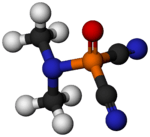Dimethylamidophosphoric dicyanide
 | |
 | |
| Names | |
|---|---|
| IUPAC name
N-Dicyanophosphoryl-N-methylmethanamine | |
| Other names
(Dimethylamido)phosphoryl dicyanide N,N-Dimethylphosphoramidodicyanidate | |
| Identifiers | |
| 3D model (Jmol) | Interactive image |
| ChemSpider | 26327732 |
| PubChem | 12673 |
| |
| |
| Properties | |
| C4H6N3OP | |
| Molar mass | 143.09 g·mol−1 |
| Hazards | |
| EU classification (DSD) |
|
| R-phrases | R26/27/28, R15/29 |
| S-phrases | (S1/2), S3/7, S36/37/39, S23, S28, S38, S45 |
| NFPA 704 | |
| Except where otherwise noted, data are given for materials in their standard state (at 25 °C [77 °F], 100 kPa). | |
| | |
| Infobox references | |
Dimethylamidophosphoric dicyanide is an important chemical for the final process of synthesizing Tabun, a nerve agent used as a chemical weapon.
Preparation
Dimethylamidophosphoric dicyanide could be prepared by reacting Dimethylamidophosphoric dichloride with sodium cyanide.
Safety
This chemical is very flammable, highly toxic, and reactive. If ingested or absorbed through skin, it will cause mild nerve agent symptoms directly as well as blood agent symptoms due to release of HCN. If mixed with water, it gives off poisonous hydrogen cyanide fumes and dimethylamidophosphoric acid.
See also
This article is issued from Wikipedia - version of the 11/1/2015. The text is available under the Creative Commons Attribution/Share Alike but additional terms may apply for the media files.

